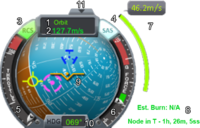How Do You Know if a Trajectory Is Prograde or Retrograde
The navball is one of the primary instruments to control the craft. Agreement the navball is critical to successful flight, both in space and in atmosphere. When the camera is not in chase way, just the navball can tell the current orientation and what the rotation commands will perform. It is similar to the artificial horizon used in real-world planes.
Contents
- 1 Betoken of reference
- i.one Speed
- 2 Ball instrument
- 2.i Level indicator
- 2.2 Markers
- ii.two.i Prograde and retrograde
- 2.2.2 Normal and anti-normal
- 2.2.three Radial in and radial out
- ii.2.4 Target and anti-target
- 2.2.five Maneuver
- 2.two.half dozen Navigation marks
- three Information around
- iii.i Maneuver information
- three.2 Throttle
- 3.three Heading
- 3.4 Pitch
- 3.five Gyre Angle
- 3.6 G forces
- iii.7 Show/Hibernate
- 4 Basic controls
- 5 Trivia

i: Current point of reference
2: Current speed
3: RCS status (active)
4: SAS status (agile)
v: Current throttle
6: Current g-force
7: Required maneuver delta-V
viii: Maneuver data
9: Navball showing orientation and several mental attitude indicators
ten: Current heading in degrees
11: Hides navball
Point of reference
As all movement in space is relative, the point of reference determines the object from which all distance measurements and velocity vectors are fabricated. Clicking this area will toggle the signal of reference betwixt Surface, and Orbit, and Target. Target mode is only available if a target is selected.
To state on the surface of a planet or other celestial trunk, information technology is important to take the reference ready to Surface to account for the rotation of the celestial body. For orbital maneuvers (i.e., not landing), the planet's rotation is unimportant, except in the case of a synchronous orbit, in which case the point of reference should exist set to Orbit, which is similar Surface merely without bookkeeping for the planet's rotation.
Speed
Your speed is measured relative to the point of reference and is given in meters per 2nd. Speed represents the magnitude of the arts and crafts's velocity vector relative to the betoken of reference. For this reason, speed is never negative. Even when you're moving toward a target (as in a docking maneuver or losing distance rapidly in a spaceplane), your speed volition ever be shown as a positive number.
Brawl instrument
The most of import part is the center brawl, which shows the current orientation of the arts and crafts and multiple directions which may be important for future movements. The blueish background hemisphere indicates the skyward direction ("upward," away from the center of gravity), while the brownish indicates the opposite ("down," toward gravity). The sparse white line separating the bluish and chocolate-brown hemispheres is the artificial horizon. These indicators are relative to the part from which the craft is controlled, not necessarily the nearest planet, target, or orbital plane. This tin exist changed by selecting Command from Here when right-clicking on docking ports or command modules that may be on the arts and crafts.
Level indicator
![]()
The level indicator is the gilded 5-shape in the middle of the navball, which shows the direction the arts and crafts is facing (its orientation). The level indicator never moves; the navball rotates beneath information technology, providing a kind of cockpit window view without whatsoever window needed. For example, rotating the craft around its curl centrality volition plow the navball upside downwardly.
Markers
On the navball are half-dozen unlike types of markers as default. All markers except the maneuver mark come in pairs, with an opposite mark on the contrary side of the virtual ball. These markers are relative to the point of reference. There are 3 pairs of directions which are identical to the vectors used in maneuver nodes, but they modify their orientation during the maneuver.
Equally the craft orbits around a body, the prograde and retrograde markers will gradually movement, considering orbits are circular (or elliptical), then the orientation of the craft's velocity is constantly irresolute.
Prograde and retrograde
| | |
The chartreuse yellow prograde marker indicates the orientation of the velocity vector of the craft relative to the indicate of reference; it indicates in which direction the vessel is moving at that moment. This may not be the direction the craft is facing (which is indicated by the level indicator). Conversely, the chartreuse xanthous retrograde marker ever faces in exactly the opposite direction. If the prograde marking is exactly aligned with the gold level indicator, the craft is facing "frontward" in the management of travel. If the level indicator is over the retrograde marking, the craft is facing "backward." As the arts and crafts orbits around a body, these markers volition gradually move, because the velocity vector is constantly changing.
Burning in the prograde direction volition advance the arts and crafts, while burning retrograde will slow it downwardly. Burning in whatsoever direction other than exactly prograde or retrograde will cause the prograde/retrograde markers to motion toward/away from the direction the craft is pointing. The prograde marking is essential during the taking off and the retrograde marking during landing maneuvers, equally the gravity turn principal aspect is the harmonization of the dispatch and velocity vectors. These directions also tin can exist used at refinement of gravity help maneuvers. The prograde acceleration tin can increase the too deep periapsis increasing the speed for slingshot maneuvers, the retrograde burning can decrease the too loftier periapsis for reserve gravity assist or aerobraking.
In Surface way, in which case the prograde and retrograde vectors will account for the rotation of the pertinent angelic torso. Basically the navball and the prograde/retrograde vectors volition act as if the ground and atmosphere don't move. This is useful for jet aeroplane navigation because air intakes and wings work on the velocity relative to the atmosphere. And finally, past sustaining alignment of the surface prograde and the horizon, the aircraft will maintain altitude, which is helpful for staying in the optimal distance for a given jet, yielding the best fuel efficiency.
In Target mode, the prograde and retrograde indicators stand for the orientation of the relative velocity between the agile vessel and the target. Prograde here is aligned with the relative velocity, while retrograde is against the vector. In other words, if you lot advance prograde in Target mode, yous are adding to the relative velocity (increasing the rate of closure or divergence) and accelerating retrograde will subtract from the relative velocity (decreasing the charge per unit of closure or departure). To hold steady with the target (i.e. maintain altitude), burn retrograde to decrease the Speed display (the magnitude of the relative velocity) is zero. However, it is important to note that if the craft and the target's orbits are not closely aligned, their different individual velocities will cause the objects to converge or diverge again--accelerating Target retrograde does not synchronize orbits. In brusk, to perform a rendezvous, set your target and then apply Orbit way to marshal the orbits and assume an intercept posture. Once your distance is reduced to about 1km or less, switch to Target mode, and accelerate retrograde until the relative velocity is zero. Finally, still in Target mode, employ the navball target vector to close to the desired separation (or the anti-target vector to separate to the desired altitude) for station-keeping or docking.
Normal and anti-normal
| | |
Equally the normal directions are orthogonal to the orbital plane, the normal or anti-normal burning will change the orbital inclination. On the navball the normal and anti-normal directions are located on the equator line directly betwixt the prograde and retrograde markers.
These directions are by and large used to match the orbital inclination of another celestial body or arts and crafts and inclined Hohmann transfers, but as a typical timed maneuvers, they are preferably executed using maneuver nodes. Just it has essential function in gravity assist as with fine refinement in normal direction of budgeted trajectory can efficiently alter the angle of the escape trajectory and enhance the final encounter.
Radial in and radial out
| | |
The radial management are in the orbital plane, and perpendicular to the prograde. The radial-in vector points inside the orbit, towards the orbited torso (on the brown hemisphere of the navball), while the radial-out vector points outside the orbit, away from the body (on the blue hemisphere of the navball). Nerdy types may notice that in Orbit mode, the radial vectors aligns with the vessel's dispatch-due-to-gravity vector, just every bit the prograde and retrograde vectors align with its velocity.
Performing a radial burn will rotate the orbit around the craft similar spinning a hula hoop with a stick. Radial burns are commonly not an efficient way of adjusting i's path - information technology is generally more effective to employ prograde and retrograde burns. The only exception when increasing or decreasing the periapsis of an escape trajectory without irresolute the speed from a afar approaching point. Decreasing the orbital speed with a retrograde burn for decreasing the periapsis for a more than efficient slingshot is not quite applied - the burn in maneuver can be more efficient. Similarly, radial out tin can increase the periapsis without increasing speed for braking maneuvers and interceptions. This direction also can have an important role at landings: moving the burning management towards the radial in direction can help control the distance, and (if the navball is in Surface fashion) foreclose the craft from flipping over to point downwards if it bounces during landing.
Target and anti-target
| | |
If a target is selected, the purple icons will indicate the heading straight to and away from the target. Considering the target is typically moving, the target markers move too. Usually the target marker and velocity marker don't follow exactly the same path and tend to drift abroad. This is important for docking, which requires frequent input to hold the craft on course. These markers are not relative to the point of reference, but to the craft itself; switching navball modes will not cause the target vectors to spring around as it would the other indicators.
Maneuver

If a maneuver is planned on the map, the bluish Maneuver marker points in the direction needed for the burn. This is the just mark without an opposite pair, just information technology does take an arrow pointing at it if the marker is non visible. (In other words, if your maneuver is coming upwardly soon and the target indicator is not visible, rotate rapidly toward the arrow if yous want to hitting your mark.)
- → Principal article: Navigation marks
Each survey contract gives possibility to mark the target expanse of the experiment on the map view. If the target area is assigned the marker of the experiment appears on the navball signing the management towards the target area. The colour of the marks differ by the contracts.
The signs of the navigation marking system:
![]()
![]()
![]()
![]()
![]()
![]()
![]()
![]()
Information around
Maneuver information
On maneuvers, in that location is a maneuver Δv indicator, a light-green bar and pocket-size info text right of the navball. The bar gives a visual indication of the total amount Δv required to accomplish the maneuver, and it volition deplete as the fire is performed. The bar has no scale; it always starts out full, regardless of the corporeality of the burn. Below that is the estimated burn time: how long the burn down will have to proceed until the maneuver is completed. This is a simple estimate based on the current maximum thrust available. When engines become activated or deactivated this value will conform automatically and may event in a longer burn down fourth dimension. The time gauge doesn't change if the engines are operated at less than 100% thrust; it simply counts down more slowly. Below the burn-fourth dimension estimate is a countdown timer indicating the fourth dimension left until the craft reaches the next maneuver node. Because a maneuver node assumes an instantaneous velocity change, a perfect burn is impossible. To become the closest to the plotted maneuver, it is recommended to fire half of the fourth dimension before the node and the other half after the node. Nonetheless, opinions vary on whether to:
- Beginning the burn earlier the maneuver signal, finishing at T-0
- Start the burn halfway earlier, so that half of the maneuver's Δv is applied at T-0
- Start the fire maneuver exactly at T-0
Throttle
Throttle indicates how much ability all engines in the electric current stage are delivering (in percent). Beware of continuous total throttle, equally engines tin overheat and be destroyed. A single throttle controls all activated engines, so if the engines are not balanced the only style to adjust individual throttles is past setting/adjusting total thrust limits of the engines by using tweakables. The throttle controls pct of maximum thrust, not accented thrust, and so smaller engines at full throttle will utilize less force than large engines at partial throttle. Solid rocket boosters cannot be throttled.
Heading
The heading is the compass direction the craft is facing, in degrees ranging from 0° - being truthful north - to 359°, going clockwise (pregnant 90° equals an eastern direction).
Pitch
Pitch is indicated in degrees, ranging from +xc° (up) to -90° (down). To ameliorate indicate positive and negative pitch, the lesser half of the navball is painted brown and the top half in blue.
Roll Bending
Roll angle is indicated using the level indicator. If the level indicator is parallel to the dashed pitch lines, the vessel is orientated horizontally. Combining this with the noesis that blue means skyward and brown ground-ward, information technology can even deduce if information technology is flying upside down past just looking at the navball.
One thousand forces
The G strength gauge provides a visual scale of the acceleration exerted due to gravity and/or craft dispatch, measured in g. One g is approximately 9.81 m/sii. Non to be confused with the SI-unit gram. G forces tin be either positive (upwards on the scale) or negative (downwards). Note that experiencing sustained excessive g forces (the red zone on the scale) will impale any Kerbalnauts and may damage sensitive parts.
Show/Hide
Clicking the fiddling arrow on the top of the navball (Hide) will toggles its brandish on-screen. In that location is also an assignable keybinding to do the same in the input menu.
Bones controls
These are the most basic orientation controls of the craft, hither is a curt explanation on how their actions are represented on the navball with the default fundamental bindings:
- Westward moves the indicator down on the navball.
- South moves it up.
- A moves information technology left.
- D moves it right.
- Q rolls it counterclockwise.
- E rolls it clockwise.
Trivia
The navball is most likely based upon the Apollo FDAI
Source: https://wiki.kerbalspaceprogram.com/wiki/Navball








0 Response to "How Do You Know if a Trajectory Is Prograde or Retrograde"
Post a Comment